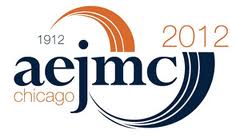SOC Faculty Present at AEJMC

| September 14, 2012 |
|---|
The School of Communication was well represented by its faculty at the conference of the Association for Education in Journalism and Mass Communication (AEJMC), held in Chicago in August. Assistant Professors Bastiaan Vanacker, Marjorie Kruvand, Seung-Chul Yoo, and David Kamerer presented their research or discussed their professional work at the international organization’s annual meeting.
The association’s annual research paper competition attracted almost 1,800 submissions, of which 49 percent were accepted for presentation at the conference.
David Kamerer, Assistant Professor of public relations and new media, was part of a panel discussing “Social Media: Metrics and Analytics” sponsored by the Electronic News and Communication Technology divisions. His presentation focused on encouraging educators to embrace teaching with web analytics.
“In the digital realm, almost everything is measurable. But are we taking best advantage of all this new information?” Kamerer said. “In most digital campaigns, we use a hub-and-spoke model, engaging with stakeholders on social networks and then moving the interaction to our web server for conversion, such as getting someone to make a purchase or sign up for a newsletter. By monitoring analytics, we can directly see what works, using this information to improve our performance, improving our campaigns.”
Marjorie Kruvand, Assistant Professor of public relations, presented a research paper, “Synthetic Biology, Real Issues: U.S. Media Coverage of Synthetic Biology,” in the Communicating about Science, Health, Environment and Risk division. Her study examined how the journalists have covered the emerging field of synthetic biology, in which scientists aim to design and build novel organisms by engineering man‑made sequences of genes and assembling them in new combinations.
Since people learn much of what they know about science and technology from the media, media representations of scientific discoveries and developments matter, Kruvand said. The sources and frames reporters use to shape their stories, as well as how the promises and potential risks of synthetic biology have been delimited and discussed, could help influence public understanding and acceptance of synthetic biology, political support, and financial investment.
Bastiaan Vanacker, Assistant Professor of media ethics, and program director for the Center of Digital Ethics, presented three research papers. The first two dealt with the 1951 live broadcast of the Kefauver hearings in Congress. The paper he presented in the History division explored how the hearings sparked a debate about the democratic potential of a new medium (television) and how the hearings should be seen as a media event. His paper in the Commission for the Status of Women interest group analyzed letters written to the senators on the Kefauver committee by female viewers and explored how the dedicated female audience disrupted established gender and TV routines in the early 1950s. The paper won the top faculty paper award in the interest group.
Vanacker also presented a paper in the Law division examining whether speech by radical Islam groups that put names and addresses of people they think blasphemed the prophet Muhammad online, together with “warnings” stating that what these critics do is dangerous and that they probably will end up dead, is protected speech under the First Amendment or a true threat that falls outside the scope of free speech.
Seung-Chul Yoo, Assistant Professor of digital advertising, and his co-author, Eunji Cho, presented a research paper, “Effects of Violent Television Programs on Advertising Effectiveness among Young Children: Findings from a Field Experiment of Kindergarten Samples in South Korea,” in the Advertising division.
The paper reported the findings of experiments conducted in kindergarten classes in South Korea to determine how violence in a TV program influenced the processing of embedded ads among the children. In terms of advertising effectiveness (advertising recall, advertising attitude, purchase intention, and product choice), the violent TV program was found to have a statistically significant impact on the processing of embedded ads. The violence elicited a high level of excitation, which substantially enhanced advertising effectiveness. The study found that children’s responses to unhealthy food advertising in violent programs are intensified. In other words, children may remember better, have more positive attitudes toward, and request more unhealthy products in ads embedded in violent programs than in nonviolent programs. The study concluded that restrictions against ads for unhealthy foods aimed at young children are needed, especially in violent TV programs.
AEJMC is an international, nonprofit, educational association of journalism and mass communication educators, students, and media professionals. Founded in 1912, AEJMC has more than 4,000 members from 32 countries.
